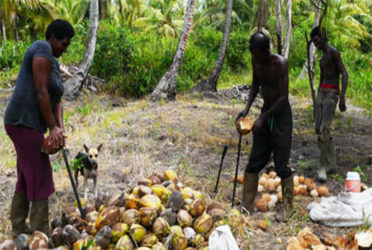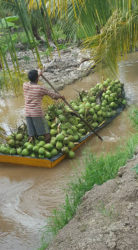This article is being published by the Stabroek Business as a service to the secretariat organizing the October 21-23 Coconut Festival being held at the Arthur Chung Convention Centre. Limited editing has been effected to take account of style and space.
The current size and economic potential of the global coconut industry provides every incentive to make significant investment of lands and other resources in the sector. This is not to say that there are not major challenges in so doing, the first being the need to make a conscious decision to pursue a long-term commitment that might even outlive the investor.
Coconut trees remain productive for decades. On the other hand, they usually have a comparatively long period of gestation prior to the start of their reproductive life. Accordingly, serious investment in the sector ought, correctly, to be attended by a succession plan designed to see the project through to fruition and to place it in a condition to be passed on to succeeding generations.
That having been established, a second important step, or challenge, if you will, is to determine the market being targeted. This determination, naturally, influences the variety and volumes of coconut brought under cultivation. Coconut oil markets usually require the taller varieties of trees which have longer gestation periods. The water coconut market customarily utilizes the shorter varieties of trees with briefer periods of gestation.
Once the decision is made, the investor must source nuts from a certified nursery or create a nursery of his or her own through training which is available at the National Agricultural Research and Extension Institute (NAREI).

NAREI is one of the critical support agencies in the development of a strong and resilient national coconut sector and is a member of the National Stakeholders Platform (NSP). The NSP comprises a number of local producers, processors, suppliers, and support agencies and is the primary local source of information that will significantly enhance the knowledge base of coconut growers, investors and potential investors. Among the key members of the NSP are the Guyana Marketing Corporation, the Inter-American Institute for Cooperation on Agriculture and the Small Business Development Finance Trust. Outside of Guyana, the NSP also has access to assistance from the Caribbean Agricultural Research and Development Institute and the Food and Agriculture Organisation.

Much of the significance of the Coconut Festival reposes in the role that it seeks to play in broadening the base of the ‘coconut community’ in Guyana by bringing local stakeholders together to discuss the potential and the future of the ‘community’ and to build lasting bridges. There is, for example, the huge challenge of resuscitating large swathes of worn-out and abandoned coconut groves in areas of the country. The publicity and the discussion centred around coconuts which the Festival and the attendant deliberations will generate will, hopefully, rekindle an interest among original investors in the sector and their living descendants in taking another tilt at a sector which is now more lucrative than ever. Reviving the abandoned groves will be a key responsibility and it will be a collective one.
Here in Guyana, the potential for growth in the sector has already gone way beyond the products derived directly from the coconut. In the local manufacturing sector, including, significantly, micro and small businesses, the coconut has found its way into snack foods, ornaments and jewellery. This adds to the efforts to continually grow the local industry through a few high-profile investments in coconut water and coconut oil, particularly, much of which has found its way onto the export market.
By the end of the Coconut Festival the local industry would not have only become a member of a much larger community of coconut adherents, including specialist coconut-related organizations, but would also have learnt much about the sector from enlightened discourses deriving from an experienced international body of knowledge.
Since the idea is to encourage larger numbers of investors to pay an interest in the sector it is apposite to make the point that once a decision has been made to invest in coconuts it is advisable to seek out opportunities to build alliances in a value chain that is connected to reliable markets. This will require the creation of a reliable supply and delivery chain. Whether one chooses to operate as an individual or to operate as part of a collective effort, what matters is the reliability of the value chain A strong value chain can offer you a quota to supply its market, provided the quality of your goods or services meets the requirements of the market at the end of the chain.





